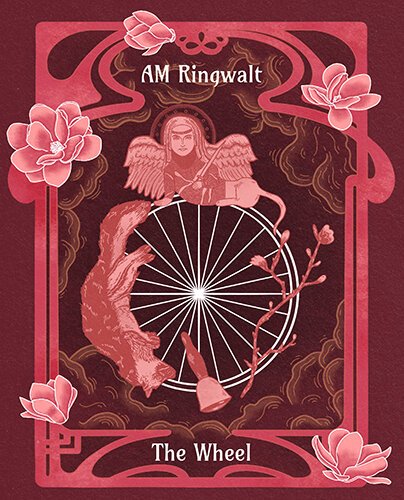The Wheel
AM Ringwalt
Reviewed by Vasantha Sambamurti
AM Ringwalt’s The Wheel is a prism: a treatise on temporality, resilience and psychic acuity that yields light at every poetic turn. This turning is part of the project’s meditation as well: “The wheel turns. The wheel turns.” This movement, rendered as meditation, guides us through the pages. We travel across the States and across Europe, making stops in California and Indiana and Massachusetts as well as a recording studio in Rome, a park in Trastevere, and the precipice of the Spanish Steps around Gucci-clad tourists. From the beginning, the speaker’s mission is clear: “I wanted to explore resonances between and beyond Christian and Pagan systems of meaning-making” in the birthplace of Tarot, Italy. In enumerating these resonances, The Wheel becomes the fruit of its own exploration.
Ringwalt navigates conversations between the artist as self, the artist as extension, and the artist as an influence; a dialogue that is rendered seamlessly. The Italian history of Tarot speaks to W.S. Merwin’s melodious translation of Dante’s Purgatorio (from which the book takes its name) and Alice Notley’s epic critique The Descent of Alette. An insistent verse from Colleen’s A flame my love, a frequency and the voices of Nina Simone and Devendra Banhart resonate in their midst. Everything is a point of influence. In acknowledging this, The Wheel creates language to speak on the very poetics that brought it into being.
Perhaps one of the most spellbinding aspects of The Wheel is its ability to portal through time without betraying a sense of its passing. The reader feels suspended in a mythos of place and witness. Poetic fragments of memory and song bookend scenes of listlessness, scenes of vulnerability and survival, scenes of longing.
Throughout, Ringwalt treats us to an accumulation of her longings: “I only want to fill this space with bells, with olive trees, with stone pines, white pillows.” The statements ring as mantra, a self-fulfilling prophecy that harnesses art as a mechanism for healing.
Each page is a spoke in The Wheel’s poetic apparatus, spinning a poetics of equilibrium and wonder that makes the reader feel as if they are held in confidence by a close friend.

